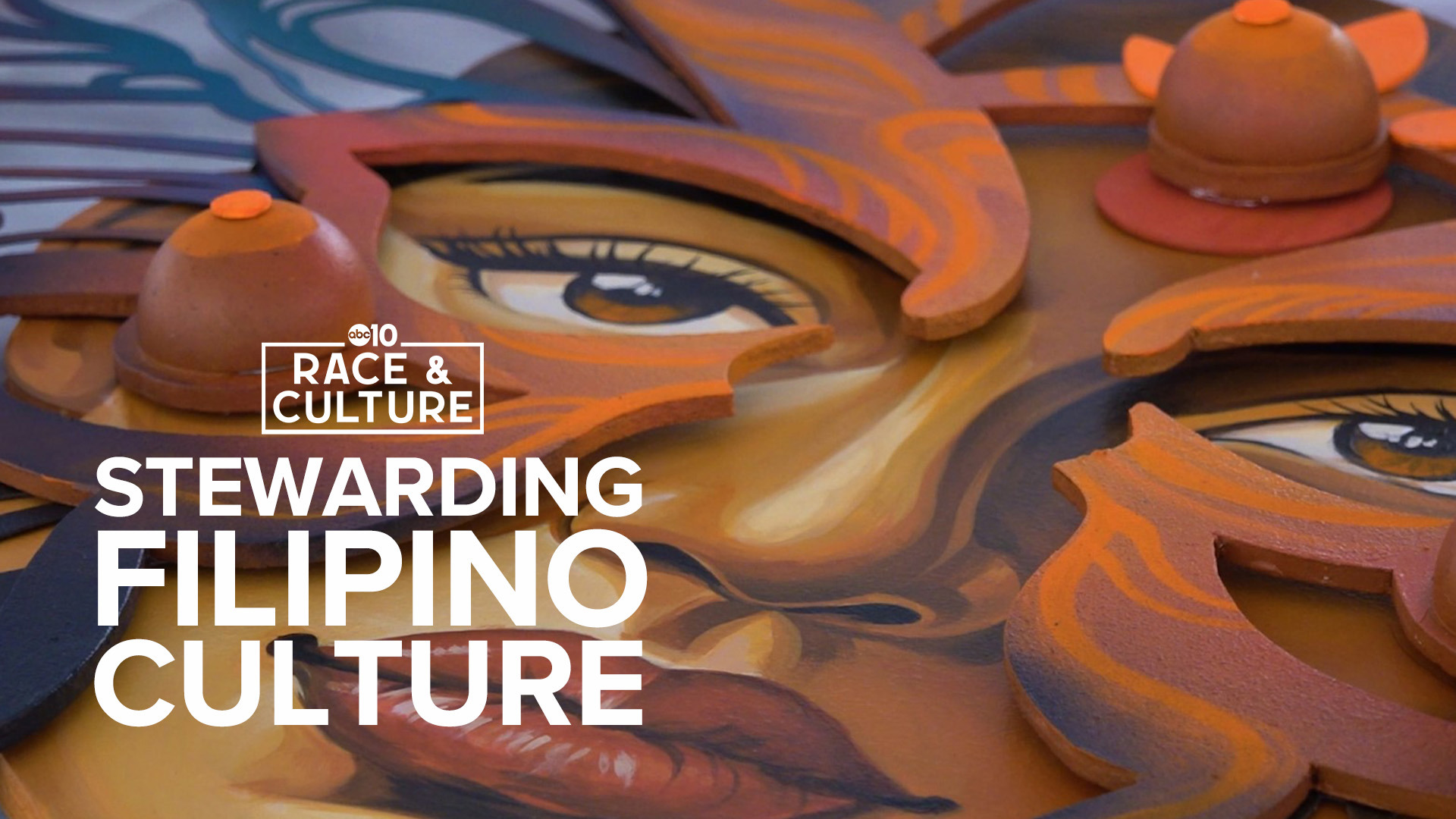SACRAMENTO, Calif. — In honor of Filipino American History Month, celebrated each year in October, 20 Filipina/x artists across the greater Sacramento region and the Bay Area brought their stories to center stage at the James Kaneko Gallery at American River College.
Through powerful visual storytelling in the forms of sculpture, paintings, an interactive altar and more, the artists explored their own identity and how they are protecting their heritage.
"Historically, a lot of the work that you see in galleries or studios or museums represent a lot of Caucasian people and I think we need spaces where all people can go and see someone that reminds them of themselves," said Niki Toney (she/her), an interdisciplinary artist and co-curator for the exhibit.
The exhibit is titled Agimat, a Tagalog word for "amulet" or "charm," which is believed to bring protection and superpowers, according to Franceska Gámez (she/her), also a co-curator and artist primarily specializing in murals.
"We wanted to spin (the theme) on its head and we gave the prompt to the artists to think about what it is that they do to not only protect, but also like steward our culture. And what does that look like for you? And on top of that, when it comes to giving strength and superpowers, what gives you strength to dismantle or challenge colonialism? What does decolonization look like for you?" Gámez explained.
GET MORE RACE & CULTURE FROM ABC10:
►Explore the Race & Culture home page
►Watch Race & Culture videos on YouTube
►Subscribe to the Race and Culture newsletter
The exhibit was born out of a desire to bring artists together for the month and uplift the community, also organized alongside Nikki Abeleda (she/they) and Shawntay Gorman (she/her).
"It's events like this that really allows us to uplift and amplify Filipinx perspectives and narratives through storytelling. This is essentially creating a portal for healing for our communities as well within the diaspora," said Abeleda, a community organizer, licensed clinical social worker and founder of Brown Blossom Rising.
"Being able to show support for our culture, our community through our art during Filipino American History Month is one of the highlights of my career," said Gorman, who describes herself as an artivist, blending art and activism.
For Jamie Cardenas (she/they), an Ilokana Filipinx multidisciplinary artist who was born and raised in South Sacramento, having access to traditional art practices such as natural indigo dyeing has allowed them to connect to a country they haven't had the opportunity to visit yet.
"I think because of colonization, there is a cultural amnesia and there's this like sense of longing and disconnect in the Filipino diaspora," she said.
For Cardenas, indigo is a representation of Kapwa, a Filipino concept that is a recognition of a shared identity with others.
"(It) means I am you and you are me, that we are not separate. And I believe, you know, indigo is a representation of that because it is this magical color that is represented in the sky and the waters. But it's also a plant that is native to the Philippines," she said.
Cardenas first learned about the the rich dye culture in the Philippines through her teachers. Her own journey with indigo started during COVID-19.
"I think people don't realize in Sacramento, there's a lot of healthcare workers here and Filipinos stand at the frontline of that, so I saw a lot of death around me," they said. "And it was kind of my way of doing all the things I wanted to do as a bucket list."
Cardenas later discovered Manila, the capital city of the Philippines, comes from the phrase Maynilà, which means "where the indigo grows."
"And then to even add to that, I discovered that my middle name translates to 'research' and my last name translates to 'blue.' So I really see this as like my life's journey as connecting with this color and sharing the story of indigo with our people," she said.
For the Agimat exhibit, Cardenas constructed a Tayum Kusikos quilt. Tayum is the Ilocano word for indigo and kusikos describes a traditional weaving pattern from the Ilocos region that is an optical illusion and a form of protection from evil spirits.
"I am taking the tradition of my grandmothers who were Inabel weavers and having that literal protection of a blanket, literal protection of being clothed," Cardenas explained.
"I think as Filipinas in the diaspora, we're constantly having to rediscover these parts of our heritage and how we want to claim those things," said Julie Bernadeth Crumb, an artist who also participated in the Agimat exhibit. "I would say that in my work, my identity shows up in sometimes unpredictable ways because something just resurfaced like a memory or an idea of something that I enjoyed as a kid growing up in the Philippines."
Bernadeth Crumb was 10 when she moved to the United States from the Philippines. Through working with sculptures, printmaking and ceramics, she always makes it a point to prioritize intuitive joy in her process.
For this particular exhibit, she shot portraits of her friend and filmmaker Shani and did Polaroid emulsion lifting, which describes the technique of transferring a Polaroid photo to paper by separating the top layer.
"I wanted to capture the sense of confidence and individuality that I share with this other person. And for the portraits, we photographed them in traditional Filipino regalia," Bernadeth Crumb said. "The person I'm capturing with the film, they also symbolize that sort of protection and that our connections with one another are what protect us."
As someone who describes herself as an emerging artist, Bernadeth Crumb said taking part in the Agimat exhibit was particularly meaningful because of the sisterhood.
"Being embraced by this community that appreciates me for who I am, you know, there are so many moments in our lives where we try to hide that or like not take ownership of it. And to me, being amongst other Filipino artists who are proudly embracing their identity is beautiful," she said.
Gámez said the exhibit is also about sparking conversations.
"I think creatives bring so much to the table, more than just a beautiful piece of art. They bring conversation. You know, a lot of artists are historians and researchers, problem solvers," she said. "When you're uplifting voices of those who have been historically marginalized, you gain this perspective that's always been there, but it's new to you. And yeah, it just adds to the history of humanity."
The exhibit can be viewed between now and Nov. 14. The gallery will be open Mondays through Thursdays from 11 a.m. to 4 p.m. and Fridays from 11 a.m. to 3 p.m. Artists featured in the exhibit include: Caralie Wegeng, Franceska Gámez, Gelli Pascual, Girlonbus, Jamie Pesquiza Cardenas, Jenesis Jade Diwa, Jo Mena, Julie Bernadeth Crumb, Julianne Marella Villegas, Ka-Bang, Kiana Jasmyne, Kiara Wondeh, Mariel Paat, Mariela Montero, Marielle Atanacio, Mindy Galloway, Niki Toney, Shawntay Gorman, Talitha De Mesa and Venazir Martinez.
Watch more Race and Culture stories: Mexican-American author Julissa Arce explores Latino identity, belonging in latest book



















